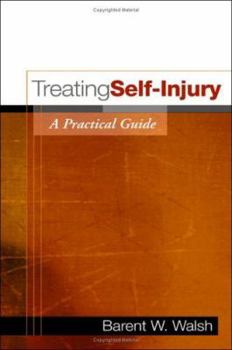Treating Self-Injury, First Edition: A Practical Guide
Select Format
Select Condition 
Book Overview
This trusted practitioner resource is acclaimed for its clear, compassionate, and hopeful approach to working with clients who self-injure. Barent Walsh provides current, evidence-based knowledge... This description may be from another edition of this product.
Format:Hardcover
Language:English
ISBN:1593852169
ISBN13:9781593852160
Release Date:October 2005
Publisher:The Guilford Press
Length:317 Pages
Weight:1.32 lbs.
Dimensions:9.5" x 1.3" x 6.5"
Customer Reviews
3 ratings
Excellent resource for Self Injury-a bit pricey, but worth it!
Published by Thriftbooks.com User , 18 years ago
This book by Barent Walsh is an excellent resource for understanding the many facets of Self Injury (SI), and for being able to move beyond SI as a means of coping. It contains case studies--real life situations with a variety/diversity of ages, genders and backgrounds. Walsh writes for the clinician, but this book is a gem for those who struggle with SI and for those who want to help/treat/support those who struggle with SI. It is a mature and compassionate book. While the price may present as prohibitive (a bit pricey), it's worth every penny. The book is up-to-date, practical and proves insightful into seemingly confusing behaviors. I highly recommend this book, along with Robin Collins, Dusty Miller, et al...
Valuable resource for understanding and treating self-injury
Published by Thriftbooks.com User , 19 years ago
In the first part of this accessible and comprehensive work, Barent does a sterling job of distinguishing the difference between self-injury and body alterations (tattoos, piercing, brands, etc.) and self-injury and suicide. Echoing my own view, he also presents a strong case for steering clear of suicidal language when referring to self-injury, for example, terms such as "attempted suicide," "suicidal gesture," and "parasuicide." The main thrust of the book is on assessment and treatment of self-injury, for which Barent proposes an inspiring bio-cognitive-behavioural approach. Topics addressed in Part Two include contingency management, replacement skills training, cognitive treatment, body image work, exposure treatment and resolution of trauma, family treatment, psychopharmacological treatment, and managing the reactions of therapists and other caregivers to self-injury. Later chapters deal with specific issues such as self-injury contagion, managing self-injury in school settings, and treating major self-injury. Overall, Barent has done a masterful job of blending facts, theories, case examples, and practical exercises to create an engaging and thorough guide to understanding, assessment, and treatment of self-injury. This excellent resource deserves a well-earned place on the bookshelves of mental health practitioners, researchers, and anyone else interested in this challenging and complex behaviour. Jan Sutton Author of Healing the Hurt Within: Understand Self-Injury and Self-Harm, and Heal the Emotional Wounds
An Excellent Text For Therapists and Those Seeking Help
Published by Thriftbooks.com User , 20 years ago
There are many self-help paperbacks already published on self-injury that are readable, helpful and under $15. "Treating Self-Injury" is written like a textbook but it is the most organized and comprehensive of all that I have seen. I would recommend it especially for school personnel or therapists who have little experience with "cutters" or those who cope through other forms of self-injury. The text would aid senior clinicians in intergrating various models into a coherent approach for treatment. The author wrote one of the first books that brought self-injury out of the medical closet, "Self-Mutilation: Theory, Research and Treatment" (1988). Too many times, self-injury is confused with suicidal ideation and this book helps to dispell a lot of old myths. Mr. Walsh has done considerable research in synthesizing what has already has been written and wrote a "bill of rights for people who self-harm" against those myths. This is not a book that will be read in one sitting but one that the reader can consult and review. A more readable approach, though more narrow and less comprehensive, is "Cutting" (1999) by Steve Levonkron (as a matter of full disclosure, I once did a conference with Mr. Levenkron years ago). "A Bright Red Scream" (1998) by Marlee Strong remains the classic in this field.





